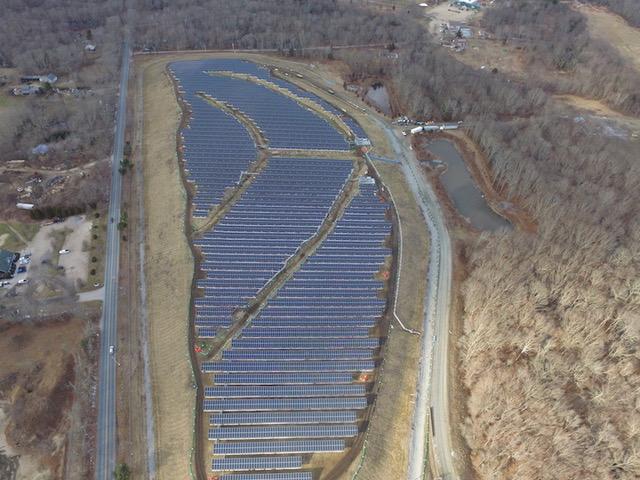Super Idea: Repurposing Toxic Sites to Produce Solar Energy
April 14, 2018

Rhode Island’s mad rush to site renewable energy on open space has become a contentious issue that concerned parties are working to resolve. A roadmap to addressing the problem can be found in Washington County, where two municipalities and the state university are developing solar energy on long-ago trashed sites.
The towns of Narragansett and South Kingstown and the University of Rhode Island are building solar facilities on two Superfund sites. This push for local energy began in 2015 with the creation of the South Kingstown Solar Consortium and a subsequent request for proposals for solar projects.
Boston-based Kearsarge Energy offered the most favorable compensation package for two sites: the former Rose Hill Regional Landfill and the closed URI waste disposal site/West Kingston town dump. Both locations had been identified at one time by the Environmental Protection Agency (EPA) as having been contaminated by hazardous waste. The properties, which had been remediated and closed, are reportedly expected to be producing solar energy in the coming months.
There is no capital cost for the two municipalities and URI. The developer, Kearsarge Energy, will supply net-meter credits to the towns and the university at a 25 percent discount. The agreement between Kearsarge Energy and the South Kingstown Solar Consortium also stipulates that the renewable energy credits (RECs) produced at the two solar facilities will stay with Kearsarge for the first 10 years before transferring to the consortium.
“Both EPA and DEM have long advocated for beneficial reuse of closed Superfund landfills. However, owners of municipal landfills must balance the risk to humans versus a beneficial reuse of a landfill with significant exposure to humans,” Jon Schock, South Kingstown’s public services director, wrote in Sept. 8, 2015 letter to town manager Stephen Alfred. “As such, solar projects have typically been deemed favorable by regulatory agencies since access by humans is relatively limited to construction.”
Here is a look at the past and future use of the two locations:
Rose Hill. The slightly larger energy producer of the two sites is 20 acres and has a capacity of 4.7 megawatts. This facility will provide energy to Narragansett and South Kingstown. The South Kingstown site is a former 52-acre municipal landfill. The town leased the land for use as a waste disposal facility, which operated from 1967 to 1983. A transfer station for municipal waste, now owned and operated by the town, is on part of the site. Other activities that have operated or are operating within the site’s boundary include a hunting preserve, skeet and qualifying range, kennel/field training area for bird dogs, and a pet cemetery.
The discovery that several private wells adjacent to the landfill were contaminated resulted in South Kingstown extending municipal water lines to affected homes in 1985. The contamination of neighboring drinking-water wells triggered further investigation by EPA and the Rhode Island Department of Environmental Management (DEM), and led to the 70-acre site being included on the federal Superfund National Priority List.
An estimated 17,300 people obtain water from wells within 3 miles of the site.
The dual investigation found an array of contaminants, including volatile and semi-volatile organics, pesticides, PCBs and metals. Volatile organics were the most prevalent of the organic compounds detected, and chlorinated and aromatic compounds and ketones were detected most frequently and in the highest concentrations.
More than 100,000 cubic yards of waste and contaminated soil were consolidated during the site cleanup. The site is bordered by the Saugatucket River to the east, and Mitchell Brook flows through the site.
The leachate from the landfill injured fish, wildlife and their habitats in Mitchell Brook, the Saugatucket River and Saugatucket Pond, according to the National Oceanic and Atmospheric Administration. Iron and hazardous substances were present at levels known to have significant impacts on the reproduction and survival of fish and other aquatic organisms. Contamination in Saugatucket Pond was of particular concern, as this area provides spawning and nursery habitat for migratory alewife and blueback herring.
URI waste disposal property/West Kingston town dump. This combined site off Plains Road is nearly 22 acres with a capacity of 4.6 megawatts. These two adjacent properties, known in the past as “South Kingstown Landfill No. 2,” received solid waste from the town of South Kingstown beginning in the 1930s.
In the early ’50s, the town of Narragansett and URI also began disposing of their solid waste in the landfill. This disposal went unregulated until 1967, when the Rhode Island Department of Health noted, during a site inspection, that waste at the site was from industrial, residential, commercial and institutional sources. Numerous operational violations were cited, and a 1975 study conducted by the URI Department of Civil Engineering and the Rhode Island Water Resources Board resulted in the discovery of a leachate plume beneath the landfill that was contaminating groundwater as far as 1,200 feet west of the dump.
From 1945 to 1987, solid waste was also accepted at the 12-acre URI disposal area, referred to in the past as the “URI Gravel Bank” or “Sherman Farm.” After closure of the town dump in 1978, this area began accepting most of URI’s waste, including oil and pesticide containers.
An estimated 15,800 people get their drinking water from three major public wells within 4 miles of the site. An additional 12,000 people are supplied by private wells, the nearest being some 1,000 feet northwest of the site. The site is within the Chipuxet River valley basin.
Categories
Join the Discussion
View CommentsYour support keeps our reporters on the environmental beat.
Reader support is at the core of our nonprofit news model. Together, we can keep the environment in the headlines.
We use cookies to improve your experience and deliver personalized content. View Cookie Settings



